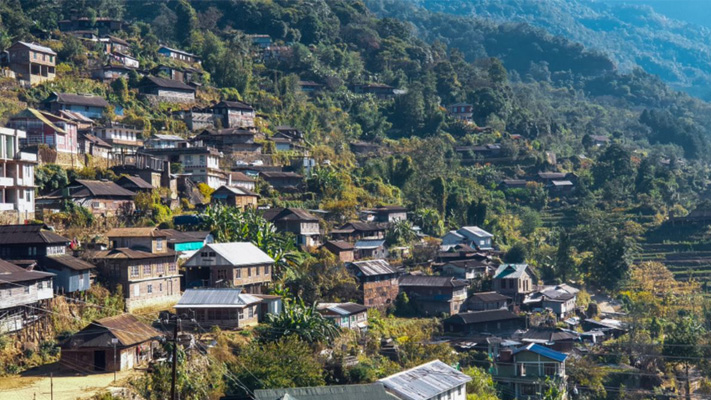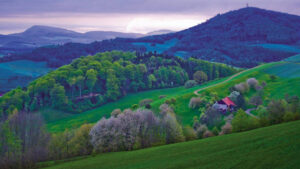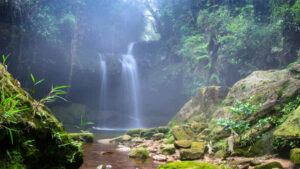TUOPHEMA, NAGALAND – A CULTURAL HAVEN AMIDST NAGALAND’S SCENIC BEAUTY

Set amidst the breathtaking hills of Nagaland, Tuophema is a destination that instantly captivates the hearts of every traveler. This charming village, located in the Kohima district, is a hidden gem that offers a mesmerizing experience steeped in the traditions and cultural heritage of the Naga tribes. With its untouched beauty, warm hospitality, and serene atmosphere, Tuophema beckons visitors to embark on a journey of discovery. From the stunning vistas of its surrounding landscapes to the immersive encounters with the local way of life, Tuophema promises an enchanting escape that will leave tourists spellbound and longing for more.

Nestled amidst lush green hills and surrounded by pristine natural beauty, this quaint village offers a unique cultural experience and an opportunity to explore the rich traditions and heritage of the Naga people. Here’s an overview of Tuophema as a destination:
- Naga Culture and Traditions: Tuophema is known for preserving and showcasing the vibrant culture of the Naga tribes. Visitors can immerse themselves in the traditional way of life, witness colorful festivals, interact with locals, and learn about Naga customs, arts, crafts, and folklore.
- Village Homestays: One of the highlights of visiting Tuophema is the chance to experience village life through homestays. Local families open their homes to guests, providing an authentic and immersive cultural experience. Staying in traditional Naga houses, enjoying local cuisine, and participating in community activities allow visitors to connect with the warmth and hospitality of the Naga people.
- Heritage Village: Tuophema has a well-maintained heritage village that showcases the traditional architecture, artifacts, and lifestyle of the Naga tribes. Visitors can explore the village, interact with skilled craftsmen, and witness demonstrations of traditional crafts such as weaving, pottery, and bamboo craftsmanship.
- Trekking and Nature Walks: The surrounding hills and forests of Tuophema offer ample opportunities for trekking and nature walks. Visitors can embark on trails that lead to scenic viewpoints, waterfalls, and serene picnic spots. The picturesque landscapes, rich biodiversity, and fresh mountain air make it a delightful experience for nature enthusiasts.
- Festivals and Celebrations: Tuophema hosts various festivals throughout the year, providing a lively and festive atmosphere. Nagaland’s famous Hornbill Festival, showcasing the cultural diversity of the state, is celebrated in December, attracting visitors from all over the world. The festival features traditional dances, music, crafts, and indigenous games, offering a vibrant celebration of Naga heritage.
Visitor Experiences and activities
Visiting Tuophema offers a range of enriching experiences and activities that allow visitors to immerse themselves in the vibrant culture and natural beauty of the region. Here are some of the top visitor experiences and activities in Tuophema:

- Cultural Immersion: Tuophema provides a unique opportunity to experience the rich traditions and customs of the Naga tribes. Visitors can engage with locals, participate in traditional ceremonies, and witness cultural performances such as folk dances, indigenous music, and storytelling sessions.
- Village Walks: Take leisurely walks through the village and explore its narrow lanes, traditional houses, and lush surroundings. Interact with friendly villagers, learn about their daily lives, and gain insights into their unique way of living.
- Trekking and Nature Trails: Surrounding Tuophema are picturesque hills and verdant landscapes that offer excellent opportunities for trekking and nature walks. Embark on scenic trails that lead to breathtaking viewpoints, cascading waterfalls, and serene picnic spots. The tranquil beauty of the natural surroundings is sure to rejuvenate the soul.
- Handicraft Workshops: Engage in hands-on activities and workshops that highlight the indigenous crafts of the Naga tribes. Learn traditional weaving techniques, pottery making, bamboo craftsmanship, and other artistic skills from skilled artisans who are eager to share their knowledge and heritage.
- Festival Celebrations: If timing permits, attending one of the festivals in Tuophema or the nearby region is a must. Experience the vibrant energy, colorful costumes, traditional music, and dance performances that accompany these celebrations. The Hornbill Festival, held in December, is a popular event that showcases the cultural diversity of Nagaland and attracts visitors from around the world.
In Tuophema, visitors have the opportunity to connect with the Naga way of life, appreciate their cultural heritage, and immerse themselves in the tranquility of the surroundings.
Top Attractions and Must Visit Places
While Tuophema is a serene village known for its cultural immersion and natural beauty, there are also several noteworthy attractions and must-visit places in and around the area. Here are some of the top attractions to explore during your visit to Tuophema:
- Kohima: Located nearby, Kohima is the capital city of Nagaland and offers a range of attractions. Visit the Kohima War Cemetery, which commemorates the soldiers who lost their lives during World War II. Explore the Nagaland State Museum, showcasing indigenous artifacts and traditional Naga art. Kohima also hosts the famous Hornbill Festival, a grand celebration of Naga culture and heritage.
- Dzukou Valley: Known as the “Valley of Flowers,” Dzukou Valley is a breathtaking natural paradise situated close to Tuophema. Trek through lush green meadows adorned with a variety of flowers and enjoy panoramic views of the surrounding hills. The valley is a haven for nature lovers and trekkers.
- Japfu Peak: Embark on a trek to Japfu Peak, the second-highest peak in Nagaland. The trek offers a challenging yet rewarding experience, with stunning views of the Naga hills and the opportunity to witness the famous Japfu Rhododendron Festival held in April-May.
- Touphema Tourist Village: Within Tuophema itself, the Touphema Tourist Village is a must-visit destination. Immerse yourself in the traditional Naga way of life by staying in the village huts, enjoying cultural performances, and engaging in traditional activities such as pottery making, bamboo weaving, and folk dancing.
- Khonoma Village: Located near Tuophema, Khonoma is a historic village known for its efforts in sustainable and eco-friendly practices. Take a walk through the village to witness its well-preserved traditional houses, explore the terraced fields, and learn about the Khonoma Nature Conservation and Tragopan Sanctuary, dedicated to protecting the endangered Blyth’s tragopan bird species.
- Dzuleke Village: Visit Dzuleke Village, a picturesque village surrounded by dense forests and verdant hills. Experience the warm hospitality of the locals, take part in village activities, and go for nature walks to explore the stunning natural landscapes.
- Pfutsero: Situated at a higher altitude, Pfutsero is known for its panoramic views of snow-capped mountains. Enjoy the cool climate, take leisurely walks amidst apple orchards, and indulge in local cuisine.

Must Try Cuisine
When visiting Tuophema in Nagaland, there are several must-try cuisines that showcase the unique flavors and culinary traditions of the Naga tribes. Here are some dishes you should sample during your visit:
- Smoked Meat: Smoked meat is a staple in Naga cuisine and is often prepared with pork, beef, or even wild game. The meat is traditionally smoked over a wood fire, which imparts a distinct smoky flavor. It is then used in various dishes, such as stews, curries, or as a side dish.
- Bamboo Shoot Curry: Bamboo shoots are widely used in Naga cooking and are a must-try delicacy. They are often cooked with local spices and herbs to create a flavorful and aromatic curry. The tender bamboo shoots add a unique texture to the dish.
- Axone: Axone, also known as fermented soybean, is a popular ingredient in Naga cuisine. It is used to enhance the flavor of many dishes, including stews, chutneys, and pickles. The strong and pungent taste of axone adds a distinct character to Naga cuisine.
- Naga Chili Sauce: Naga cuisine is known for its love of spicy food, and the Naga chili sauce perfectly represents this. Made with local chili peppers, garlic, and other ingredients, this fiery sauce adds a kick to any dish. It’s a must-try for those who enjoy spicy flavors.
- Galho: Galho is a traditional Naga rice soup that is both comforting and delicious. It is made with rice, meat (usually pork), and various local vegetables. The flavors blend together to create a hearty and satisfying dish.
- Naga Sticky Rice: Naga sticky rice is a popular staple that accompanies many Naga meals. The sticky and glutinous rice has a slightly sweet taste and is often eaten with various curries and meat dishes.
- Chutneys and Pickles: Naga cuisine boasts a wide array of chutneys and pickles that add a burst of flavor to any meal. These condiments are made with local ingredients like chili peppers, garlic, ginger, and fermented bamboo shoots. They provide a tangy and spicy complement to the main dishes.

Best Time to Visit
The best time to visit Tuophema, Nagaland is during the months of October to March. During this period, the weather is pleasant with mild temperatures, making it ideal for exploring the village and its surrounding attractions. The months of October and November offer comfortable temperatures, clear skies, and the opportunity to witness the vibrant festivals and cultural events of the region. December to March brings cooler temperatures, creating a pleasant ambiance for outdoor activities and sightseeing. It’s a great time to immerse yourself in the local traditions and engage in activities like pottery making, bamboo weaving, and folk dancing. Whether you’re seeking cultural immersion or nature exploration, visiting Tuophema during the recommended months ensures an enjoyable and memorable experience.

















































